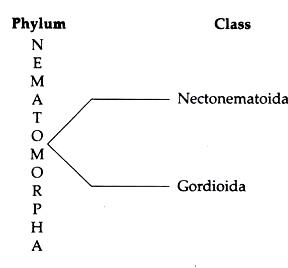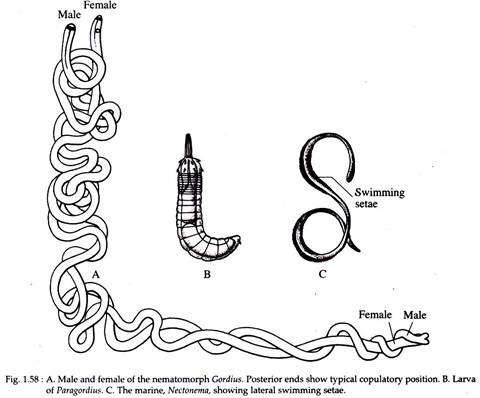In this article we will discuss about Phylum Nematomorpha:- 1. Introduction to Phylum Nematomorpha 2. Diagnostic Features of Phylum Nematomorpha 3. Scheme of Classification 4. Systematic Resume.
Introduction to Phylum Nematomorpha:
The phylum Nematomorpha constitutes of long worms known as horse hair worms or hair worms. Superficially the bodily organization of adult nematomorphs resembles the nematodes and like them they move by means of undulatory waves passing along the body in the dorsoventral plane.
The adult nematomorphs of most species live in fresh water or in damp soil. The larval stages are parasitic in arthropods (rarely in human) and are the dominant stage in the life cycle.
Etymology:
ADVERTISEMENTS:
Greek: nematos, thread; morphe, form.
Diagnostic Features of Phylum Nematomorpha:
i. Body bilaterally symmetrical, threadlike, extremely long and slender and without a distinct head.
ii. It measures about 3 mm in diameter and 10 cm to more than 1 metre in length.
iii. Body more than two cell layer thick, with tissues and organs.
ADVERTISEMENTS:
iv. Body wall comprises of a thick outer, iridescent cuticle made of collagen fibres. Beneath it is a cellular epidermis and obliquely striated longitudinal muscle layer. Circular muscle layer absent. .
v. Body monomeric, with a pseudo- coelomic cavity, often occluded by mesenchyme.
vi. The digestive tract is vestigial and probably always non-functional as the adults do not feed.
vii. Absence of circulatory, excretory or gaseous exchange organs.
ADVERTISEMENTS:
viii. Nervous system is composed of an anterior nerve ring and one or two non- ganglionated longitudinal ventral cords.
ix. They are dioecious with elongated, one or two gonads that extend the entire length of the body.
x. Fertilization is internal via spermatophores.
xi. Development via an infectious Gordian larva that infects arthropods, developing in their haemocoel; juveniles with three oral stylets and three whorls of hooked scalids.
xii. Adults free-living but short lived.
Scheme of Classification of Phylum Nematomorpha:
The 250 known species of phylum Nematomorpha have been placed in two classes by Ruppert and Barnes (1994).
Systematic Resume of Phylum Nematomorpha:
Class Nectonematoida:
i. Body 20 cm long and has lateral swimming setae.
ADVERTISEMENTS:
ii. Body cavity is a fluid-filled pseudocoel.
iii. Presence of dorsal and ventral nerve cords.
iv. A single discrete (male) or diffuse (female) gonad.
v. Larvae and juveniles parasitize upon decapod crustaceans.
vi. Adults are marine in habitat.
Examples:
Nectonema (Fig. 1.58C).
Class Gordioida:
i. Body cavity filled with parenchyma in recently emerged adults (later a pseudocoel)
ii. Only ventral nerve cord is present.
iii. Presence of paired gonads.
iv. Juveniles parasitize on insects.
v. Adults are fresh water and semiterrestrial in habit.
Examples:
Gordius (Fig. 1.58A), Paragordius (Fig. 1.58B), Chorododes.

